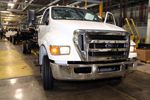Shedding Weight of Utility Fleet Upfits to Boost Payload and Productivity
New diesel emissions aftertreatment devices – including diesel particulate filters, selective catalytic reduction systems and diesel exhaust fluid tanks – have added considerable weight to medium- and heavy-duty truck chassis in recent years. This has contributed to a payload challenge for many fleet managers, especially for those utility fleets operating Class 7 and 8 digger derrick and aerial platform trucks. They’re looking to keep their trucks within a certain weight range to comply with federal bridge laws and, if possible, avoid having to bump up to a larger chassis that may require a federal excise tax.
A federal excise tax applies to the first retail sale of a truck with a gross vehicle weight rating of 33,001 pounds and above, adding 12 percent of the purchase price to the total cost of a truck. So, having to go to a bigger chassis could mean as much as a five-figure increase to the cost of each truck. Spread that added expense across an entire fleet, and you get the idea of the financial stakes at hand with truck weight.
How can fleet managers reduce overall vehicle weight without having to upsize the truck? One solution is to shed weight from the body and equipment that are mounted on the chassis, replacing conventional steel – where feasible – with advanced lightweight materials such as aluminum, fiberglass composites, plastic composites and thinner-gauge steel.
Lightweight Potential
Conventional steel is the predominant material used in truck bodies because of its relatively low cost and the comfort level that many fleet managers have with its strength and durability to hold up under rugged working conditions. But steel is also heavy, and replacing it with lighter-weight materials could offer substantial weight savings and increased payload capacity.
According to Joe Caywood, senior marketing and product manager for Terex Utilities (www.terex.com), a global manufacturer of aerial work platforms, using fiberglass and aluminum can reduce the weight of a line body, also known as a utility body, by about 38 percent. So, what impact does that make in terms of real-world payload?
Take, for example, a standard steel 156-inch line body, which weighs about 2,300 pounds, Caywood said. Reducing the weight of that body by 38 percent translates into an increased payload capacity of 860 pounds.
Then there’s lightweighting the equipment mounted on the body. Caywood said that Terex has been able to generate 15 to 25 percent weight savings in their aerial platforms and other equipment by incorporating some high-strength steel – which is thinner and lighter than traditional steel, but with comparable strength – in the company’s upfit designs.
A side benefit of some lightweight materials, specifically aluminum, fiberglass and plastics, is corrosion resistance, which is important for the longevity of upfits. They must be able to withstand the corrosive impact of road salt in the Snowbelt states and salt air in coastal regions.
“Many fleets evaluate body material selection based on the region where the vehicle will operate,” said Justin Chandler, body sales manager for Altec Inc. (www.altec.com), a truck equipment manufacturer and service provider for the electrical utility and telecommunications market that offers fiberglass and aluminum bodies as part of its Green Fleet product line. “Some fleets may use more fiberglass in a region that is an intense corrosive environment, whereas steel – which is less expensive – may work fine in a less corrosive environment. The key is to find the best material solution for each customer based on the factors most important to them, whether it’s weight, cost or corrosion resistance.”
Balancing Act
Since lightweight materials tend to cost more than steel, too much of an advanced material could drive up the cost to a point where it’s not financially practical. And then there’s the issue of material strength, which impacts body durability and performance.
“Generally, you want to stick with steel for the understructure of the body, especially in utility applications, because of the potential twist and torque of the body, whether the truck is going off-road or carrying a crane or an aerial device,” said Eric Paul, regional sales manager for ETI (www.etiequipment.com), a manufacturer of aerial lifts, mobile service cranes and custom bodies.
Where are the most appropriate opportunities for lightweighting the body while keeping costs in line and without sacrificing structural strength?
“You want to look at nonstructural areas in the body – the side packs [the side compartments in line bodies], doors, floor pan – any area of the body that doesn’t absorb a tremendous amount of stress,” Paul said. “Fleets may wish to also consider composite bushings and aluminum or composite shelving.”
Said Caywood, “Look for opportunities, such as wire holders or different components of the body for storage that can be made out of aluminum or other lightweight material. Even something as simple as redesigning to reduce the inches of weld in the body design can reduce weight.”
“Lightweighting is a big balancing act,” Paul said. “And when it comes to selecting lightweight materials for a body, there is no one-size-fits-all solution. There needs to be an engineering mindset about it. Recognize the physical properties of each of the various materials and strategically include the right mix of materials for the body to do the job it has to do.”
Reducing weight of upfits will help increase payload capacity, but not all lightweight materials are created equal or suitable for every situation. Therefore, when considering lightweight upfits, work closely with your body manufacturer and upfitter to select materials that best fit the application – and your budget.
About the Author: Sean M. Lyden is a nationally recognized journalist and feature writer for a wide range of automotive and trucking trade publications, covering fleet management strategies, light- and medium-duty trucks, truck bodies and equipment, and green fuel technologies. He blogs at Strategy + Writing (www.seanmlyden.com).










